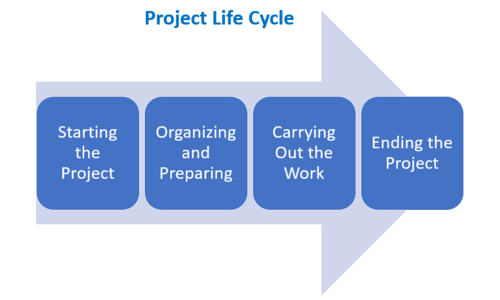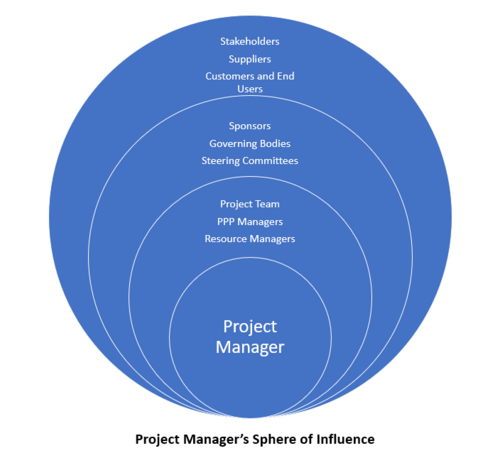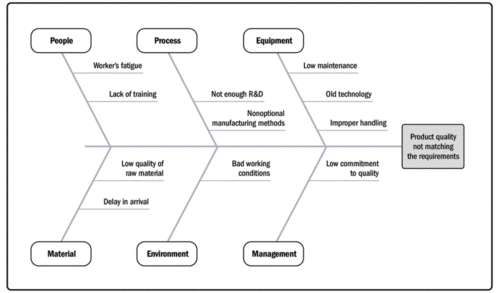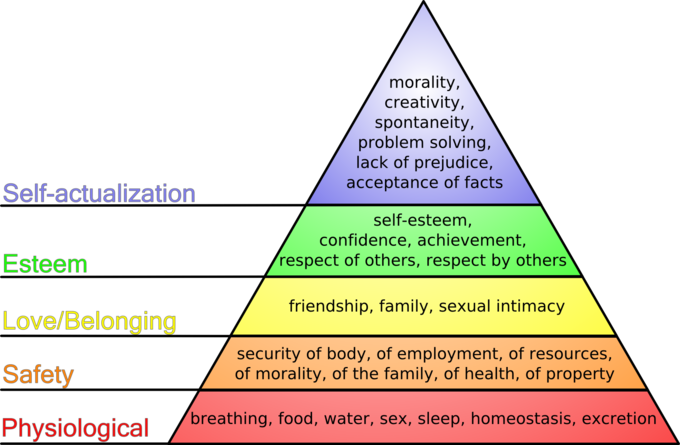Maslow's Hierarchy of Needs and Project Management
(→Abstract) |
(→Annotated Bibliography) |
||
| Line 123: | Line 123: | ||
== Annotated Bibliography == | == Annotated Bibliography == | ||
| − | *''' | + | *'''A Theory of Human Motivation, A. H. Maslow (1943), Originally Published in Psychological Review, 370-396.''' |
This book was written by Abraham Maslow. In order to understand his theory from first hand, this book should be read. | This book was written by Abraham Maslow. In order to understand his theory from first hand, this book should be read. | ||
| + | |||
| + | *'''Maslow, A,H., Motivation and Personality. 3rd edition 1987, HarperCollins Publishers''' | ||
| + | This book was written by Abraham Maslow. From. | ||
*'''Guide to the Project Management Body of Knowledge, Project Management Institute (PMBOK® Guide) (6th Edition)''' | *'''Guide to the Project Management Body of Knowledge, Project Management Institute (PMBOK® Guide) (6th Edition)''' | ||
Revision as of 20:52, 22 February 2019
Developed by Osman Furkan Simsek
Contents |
Abstract
In 1943, Abraham Maslow wrote his theory named “Hierarchy of Needs”. This theory explains that humans have different category of needs and these needs have different importance in the pyramid of needs. Without satisfying the basic needs of the hierarchy, generally, people do not think about their higher needs. When people fulfil one of their needs, another need takes place of it in our minds. There are five stages of human needs.[1]
• Physiological Needs
• Safety Needs
• Love/Belonging Needs
• Esteem Needs
• Self-Actualization
Using this theory, I wrote the hierarchy of needs for project managers. The project manager is the person assigned by the performing organization to lead the team that is responsible for achieving the project objectives.[2] It means project managers are directly in contact with their team as a leader or manager. Therefore, they need to know how their team’s needs for managing and motivating them through the project aims. Although Maslow developed his theory for explaining induvial human behaviour and motivation, project management teams are consisting of individuals and their cooperation. In this concept, I evaluate the team as an individual.
There are two different purposes of this article. The first aim is showing the linkage between project management and Maslow’s Hierarchy of Needs theory and the second is helping project managers to understand their team’s needs and motivate the team. By gratifying the needs of the project team, the project manager can efficiently manage the project. In this paper, there are practical advises that can be deduced from the theory in the “project team needs” chapter.
Maslow's Hierarchy of Needs
Figure 1: Maslow's Hierarchy of Needs [3]Abraham Maslow wrote the “Hierarchy of Needs” theory. He studied human motivation and successful people’s life such as Albert Einstein, Jane Addams, Eleanor Roosevelt and Frederick Douglas. Maslow argued that humans are motivated with unsatisfied needs and more basic needs should be satisfied before more complex needs. There are 5 different types of needs in his pyramid, which are physiological, safety, love/belonging, esteem, self-actualization needs.[4] People should fulfil these needs step by step. All our behaviours can be explained by our needs and human life is going through satisfying these needs. To explain this theory better, I examine the needs more detailly.
Physiological Needs
Physiological needs are survival for the human. Eating food, drinking water, breathing air, sleep, etc. can be given as examples. When these needs are not satisfied, people cannot think or be motivated about other topics.[5]
Safety Needs
After Physiological needs are gratified, human will start to think about his or her safety. Safety helps people to create stability and consistency in a chaotic world. Needs can be categories here as security, stability, dependency, freedom from fear, order, law, etc.[6] For example, when a person does not have a salary or economic safety, we can not accept that this person will be motivated for a higher purpose than money. Because when someone does not trust that he will take his salary next month, he will not be motivated for his work. Or in unhappy marriages can be given as an example in this need. When you know that there is an abusive husband who is waiting for you at home, the wife will not think about other subjects than her safety at home.
Love/Belonging Needs
Love and Belongings are the needs coming after feeling safe in life. Humans are social animals. Therefore, in order to feel good, people need to be part of a group, love and being loved are necessary. Teenagers want to fan group of a rock band, football fans coming together and sing, lovers show their feelings to each other, etc. All these examples can be thought of this category. In my opinion, in the management perspective, one of the most important needs is belonging needs for the project teams.
Esteem Needs
Esteem needs include two different categories. First is self-esteem which is coming from competence or mastery of a task. Second is the attention and respect from other people. Maslow said that “All people in our society (with few pathological exceptions) have the need or desire for a stable, firmly based, usually high evaluation of themselves, for self-respect or self-esteem, and for the esteem of others. These needs may, therefore, be classified into two subsidiary sets. These are, first, the desire for strength, achievement, adequacy, mastery and competence, confidence in the face of the world, and independence and freedom. Second, we have what we may call the desire for reputation or prestige (defining it as respect or esteem from other people), status, fame, and glory, dominance, recognition, attention, importance, dignity, or appreciation.”[7] In other words, people need to see respect and recognition in life. When a scientist got a prize for his or her scientific study, he or she will see the respect of the scientific community and feel self-esteem. I think most of the white colour workers like engineers, doctors, lawyers are getting motivated when they see respect and recognition for their work.
Self-Actualization
Self-Actualization is the last step of the needs. The human can show all their potential when they reach this last point of the pyramid. Maslow thought that only a few people can achieve self-actualization, for instance, Albert Einstein had become one of the most famous scientists with his contribution to physic. This kind of people can seek knowledge, peace, esthetic experiences, self-fulfillment, etc.[8]
Project Team Needs
Before starting the chapter, there are 3 concepts that should be defined. In this chapter, the project management team’s needs are focused on.
- Project Management:The application of knowledge, skills, tools, and techniques to project activities to meet the project requirements.
- Project Management Team:The members of the project team who are directly involved in project management activities.
- Project Manager: The person assigned by the performing organization to lead the team that is responsible for achieving the project objectives.[2]
Maslow wrote his theory for individual needs and the teams are consisting of many individuals working cooperatively. In order to motivate the team, project managers should know their needs. Especially the first four steps of the pyramid are directly related to project managers. In this chapter, the project team is evaluated as an individual. The purpose of the project team in the project management is achieving project on time, on budget with success.
Physiological Needs
Physiological conditions are important for the project manager. Project managers should think about their teams’ physiological needs. They should ask themselves about “Are the team members sleeping enough, are they coming work after breakfast, is office cleaned and ventilated?”
Safety Needs
Before project managers establishing their team, it is important to know team members psychology. Some people can be in the hard times of their life and it can not be expected from these people to being efficient. After the team selected, the project manager must be sure that every team member is paid regularly and feeling safe in the work environment. Questionnaires and individual meetings can be done for this purpose. Team members should know that if they make a small mistake, they will not be fired. Otherwise, they can not feel free and work efficiently.
Belonging Needs
As social animals, the human need to be part of a group. For thousands of years, it was crucial to be a member of a group, in order to survive and exclusion from the group could be fatal for our ancestors. Project managers should create awareness of being a team for each team member. “Collaboration in the team is smoother and efficient when the team members feel that they belong to the team and place the needs of the team over personal needs. Companies promote team building via company-sponsored picnics, retreats etc.”[9] Team is motivated to perform well and work towards the project’s goals, when they feel that they are the part of bigger aim. For example, the projects are part of programs and the programs are part of portfolios. When the team members understand the big picture, they feel more motivated. Therefore, project managers should also motivate the team by socializing activities together.
Esteem Needs
Project teams seek to be competent and efficient so they can gain respect and prestige from the other people.[10] From the project managers' perspective, it is important to show respect and appreciate project members successes. It is also important for program and portfolio managers because every individual has these needs. So, program managers should motivate project managers and portfolio managers should motivate program managers by filling their esteem needs.
Self-Actualization
In my view, self-actualization is rare in the project management level. However, every individual is different and has different aims. Some project managers might find themselves in their life devoted project. Program or portfolio managers could achieve their life goal with an important program or portfolio. In this article, I limited the subject with project management area. Thus, I do not focus on self-actualization.
Perspective of Project Manager
The project manager plays a critical role in the leadership of a project team in order to achieve the project’s objectives. This role is clearly visible throughout the project. Many project managers become involved in a project from its initiation through closing in the project life cycle.[11]

Project Manager
“Project manager is the person assigned by the performing organization to lead the team that is responsible for achieving the project objectives. A simple analogy may help in understanding the roles of a project manager for a large project by comparing them to the roles of a conductor for a large orchestra:

Leadership and dealing with people are very important qualities for project management. Without knowing people’s need, it is impossible to be successful in this duty. That’s why project managers should be aware of the 5 stages of needs.
“Leadership skills involve the ability to guide, motivate, and direct a team. These skills may include demonstrating essential capabilities such as negotiation, resilience, communication, problem-solving, critical thinking, and interpersonal skills. Projects are becoming increasingly more complicated with more and more businesses executing their strategy through projects. Project management is more than just working with numbers, templates, charts, graphs, and computing systems. A common denominator in all projects is people. People can be counted, but they are not numbers. A large part of the project manager’s role involves dealing with people. The project manager should study people’s behaviours and motivations. The project manager should strive to be a good leader because leadership is crucial to the success of projects in organizations. A project manager applies leadership skills and qualities when working with all project stakeholders, including the project team, the steering team, and project sponsors.”[14]
People’s effect can be shown in the bigger perspective of cause and effect diagram. Without motivation, people may be a reason for product quality not matching the requirements.[15]

Role of the Project Manager
“The project manager is the person assigned by the performing organization to lead the team responsible for achieving the project objectives. The project manager’s reporting relationships are based on the organizational structure and project governance. In addition to any specific technical skills and general management proficiencies required for the project, project fic technical skills and general management proficiencies required for the project, project managers should have at least the following attributes:
• Knowledge about project management, the business environment, technical aspects, and other information needed to manage the project effectively;
• Skills needed to effectively lead the project team, coordinate the work, collaborate with stakeholders, solve problems, and make decisions;
• Abilities to develop and manage scope, schedules, budgets, resources, risks, plans, presentations, and reports;
• Other attributes required to successfully manage the project, such as personality, attitude, ethics, and leadership. Project managers accomplish work through the project team and other stakeholders. Project managers rely on important interpersonal skills, including, but not limited to:
• Leadership,
• Team building,
• Motivating,
• Communicating,
• Influencing
• Decision making,
• Political and cultural awareness,
• Negotiating,
• Facilitating,
• Managing conflict,
• Coaching.
The project manager is successful when the project objectives have been achieved. Another aspect of success is stakeholder satisfaction. The project manager should address stakeholder needs, concerns and expectations to satisfy relevant stakeholders. To be successful, the project manager should tailor the project approach, life cycle, and project management processes to meet the project and product requirements.” [16] Maslow’s hierarchy of needs can help to project manager while, he or she is building, leading and motivating the team. Because the theory is explaining how to motivate human by showing their needs.
Limitations and Criticisms
Annotated Bibliography
- A Theory of Human Motivation, A. H. Maslow (1943), Originally Published in Psychological Review, 370-396.
This book was written by Abraham Maslow. In order to understand his theory from first hand, this book should be read.
- Maslow, A,H., Motivation and Personality. 3rd edition 1987, HarperCollins Publishers
This book was written by Abraham Maslow. From.
- Guide to the Project Management Body of Knowledge, Project Management Institute (PMBOK® Guide) (6th Edition)
This book explains basic knowledge about project management and the project team. I could link between Maslow's Hierarchy of Needs and Project management thanks to this book.
- A. Sarma, A. Van Der Hoek, “A Need Hierarchy for Teams Introduction Maslow ’ s Need Hierarchy,” Exch. Organ. Behav. Teach. J., pp. 1–5, 2004.
This article explains how Maslow's Hierarchy of Needs theory can help to increase the efficiency of software development teams.
References
- ↑ A Theory of Human Motivation, A. H. Maslow (1943), Originally Published in Psychological Review, 370-396.
- ↑ 2.0 2.1 Guide to the Project Management Body of Knowledge, Project management Institute (PMBOK® Guide) (6th Edition) part 3 page 716
- ↑ Maslow hierarchy of needs DTU Wiki Article. http://apppm.man.dtu.dk/index.php/Maslow_hierarchy_of_needs
- ↑ A. Sarma, A. Van Der Hoek, “A Need Hierarchy for Teams 1 Introduction Maslow ’ s Need Hierarchy,” Exch. Organ. Behav. Teach. J., pp. 1–5, 2004.
- ↑ A. Sarma, A. Van Der Hoek, “A Need Hierarchy for Teams, Physiological Needs Maslow ’ s Need Hierarchy,” Exch. Organ. Behav. Teach. J., pp. 1–5, 2004.
- ↑ A. Sarma, A. Van Der Hoek, “A Need Hierarchy for Teams, Safety Needs Maslow ’ s Need Hierarchy,” Exch. Organ. Behav. Teach. J., pp. 1–5, 2004.
- ↑ Maslow, A,H., Motivation and Personality. 3rd edition 1987, HarperCollins Publishers, 293.
- ↑ A. Sarma, A. Van Der Hoek, “A Need Hierarchy for Teams, Self-Actualization Maslow ’ s Need Hierarchy,” Exch. Organ. Behav. Teach. J., pp. 1–5, 2004.
- ↑ A. Sarma, A. Van Der Hoek, “A Need Hierarchy for Teams, Belonging Needs Maslow ’ s Need Hierarchy,” Exch. Organ. Behav. Teach. J., pp. 1–5, 2004.
- ↑ A. Sarma, A. Van Der Hoek, “A Need Hierarchy for Teams, Esteem Needs Maslow ’ s Need Hierarchy,” Exch. Organ. Behav. Teach. J., pp. 1–5, 2004.
- ↑ 11.0 11.1 Inspired From Guide to the Project Management Body of Knowledge, Project management Institute (PMBOK® Guide) (6th Edition) Project Life Cycle part 1 page 18
- ↑ Guide to the Project Management Body of Knowledge, Project management Institute (PMBOK® Guide) (6th Edition) part 1 page 51-52
- ↑ 13.0 13.1 Inspired From Guide to the Project Management Body of Knowledge, Project management Institute (PMBOK® Guide) (6th Edition) part 1 page 53
- ↑ Guide to the Project Management Body of Knowledge, Project management Institute (PMBOK® Guide) (6th Edition) part 1 page 60
- ↑ 15.0 15.1 Inspired From Guide to the Project Management Body of Knowledge, Project management Institute (PMBOK® Guide) (6th Edition) part 1 page 293-294
- ↑ Guide to the Project Management Body of Knowledge, Project management Institute (PMBOK® Guide) (6th Edition) part 2 page 552
Reading Suggestions to Related Wiki Articles
- Maslow hierarchy of needs, [1]
- Motivation in Project Management from the Project Manager’s Perspective, [2]
- Servant Leadership, [3]
- Dan Pink on Motivation, [4]
